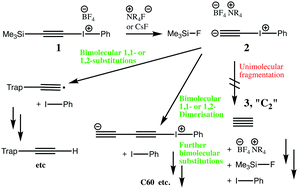Routes involving no free C2 in a DFT-computed mechanistic model for the reported room-temperature chemical synthesis of C2
Abstract
Recent lively debates about the nature of the quadruple bonding in the diatomic species C2 have been heightened by recent suggestions of molecules in which carbon may be similarly bonded to other elements. The desirability of having methods for generating such species at ambient temperatures and in solution in order to study their properties may have been realized by a recent report of the first chemical synthesis of free C2 itself under mild conditions. The method involved unimolecular fragmentation of an alkynyl zwitterion 2 as generated from the precursor 1, resulting in production and then trapping of free C2 at ambient temperatures rather than the high temperature gas phase methods normally employed for C2 generation. Here, alternative mechanisms are proposed for this reaction based on DFT calculations involving bimolecular 1,1- or 1,2-iodobenzene displacement reactions from 2 directly by galvinoxyl radical, or hydride transfer from 9,10-dihydroanthracene to 2. These mechanisms result in the same trapped products as observed experimentally, but unlike that involving unimolecular generation of free C2, exhibit calculated free energy barriers commensurate with the reaction times observed at room temperatures. The relative energies of the transition states for 1,1 vs. 1,2 substitution provide a rationalisation for the observed isotopic substitution patterns. The same mechanism also provides an energetically facile path to polymeric synthesis of carbon rich species by extending the carbon chain attached to the iodonium group, eventually resulting in formation of amorphous carbon and discrete molecules such as C60.



 Please wait while we load your content...
Please wait while we load your content...